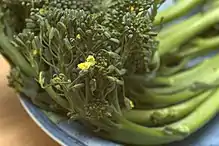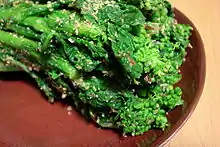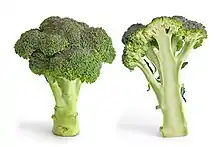Broccolini
Broccolini or baby broccoli is a green vegetable similar to broccoli but with smaller florets and longer, thin stalks. It is a hybrid of broccoli and gai lan (which is sometimes referred to as "Chinese kale" or "Chinese broccoli"), both cultivar groups of Brassica oleracea. The name broccolini is a registered trademark of Mann Packing.[1]
| Broccolini | |
|---|---|
 | |
| Scientific classification | |
| Kingdom: | |
| (unranked): | |
| (unranked): | |
| (unranked): | |
| Order: | |
| Family: | |
| Genus: | |
| Species: | B. oleracea |
| Cultivar Group | |
|
Brassica oleracea | |


History
Broccolini was originally developed over eight years[2] by the Sakata Seed Company of Yokohama, Japan. It was developed as a hybrid of broccoli and Chinese cabbage, rather than being genetically modified.[3]
Sakata partnered with Sanbon Incorporated in 1994 to begin growing the product commercially in Mexico under the name Asparation, implying a similarity to asparagus due to the slim, edible stem. After first becoming available in US markets in 1996, in 1998 Sakata began a partnership with Mann Packing Company in Salinas, California, and marketed the product as Broccolini.[4] New forms of broccolini continue to be developed, including purple broccolini.[5]
Description
Broccolini has a similar structure to sprouting-type broccoli. It grows to 80 centimeters, with a slender elongated stem that is 15–30 centimeters long. It is annual or biennial, herbaceous and glaucous.
Consumption
The entire vegetable (leaves, young stems, unopened flower shoots, and flowers) is consumable. Its flavor is sweet, with notes of both broccoli and asparagus,[6] although it is not closely related to the latter.
Common cooking methods include sauteeing, steaming, boiling, and stir frying. According to a 2005 Horticulture Australia study, 78% of people in Australia steam broccolini, 53% stir fry it, and 3% eat it raw or in a salad.[7] It is usually eaten steamed in Japan, where it is highly popular as a spring vegetable.
Nutrition
Broccolini is high in vitamin C and contains a significant amount of vitamin A and dietary fiber. One cup (122 g/4.3 oz) contains 37 calories (155 kJ) with 105% of daily vitamin C intake, 39% of vitamin A needs and 15% of dietary fibre needs. Broccolini also contains potassium, calcium and iron in smaller amounts.[8]
Production
Climate
Broccolini grows in cool climates and is intolerant of extreme climates. It is more sensitive to cold temperatures than broccoli but less sensitive to hot temperatures.[9]
Growth and distribution
Broccolini takes 50–60 days to grow after being transplanted. It is harvested when the heads are fully developed but are not flowering. By cutting off the head, the harvest time is extended by four weeks as new shoots of smaller heads will grow. After being harvested, the plant is cooled to 0 °C, preventing the flower heads developing.[10][11]
Broccolini is grown near the central California coast during the spring, summer, and fall seasons and Yuma, Arizona, throughout the winter. It is sold throughout the United States, Canada, and the United Kingdom, as well as five states in Australia.[11]
Produce reference
The International Federation for Produce Standards assigns it the price look-up code 3277, "baby broccoli". It is also known as asparation, asparations, "sweet baby broccoli", broccoletti, and broccolette[12] "Italian Sprouting broccoli",.[13] In Brazil, the common form of the word broccoli ("brócolis") refers to broccolini; the more traditional broccoli is called "brócolis americano" (American broccoli) or "brócolis ninja" (ninja broccoli). It is sold under the registered trade marks BIMI and TENDERSTEM.
References
- "BROCCOLINI (Reg. No. 2365625)". Trademark Status & Document Retrieval (TSDR). United States Patent And Trademark Office. Retrieved 30 April 2019.
- Chef, Volume 8. 1998. p. 16.
- "Sakata Home Grown Presents: Broccolini® Ideas". Sakata Vegetables. 1 January 2013. Archived from the original on 12 April 2018. Retrieved 22 September 2016.
- "Broccolini". Washington State University. Retrieved 17 September 2016.
- Tsunehiro Yagoshi, Kakegawa (2017). "Purple baby broccoli". Google Patents. Retrieved 28 March 2019.
- "朝日新聞グローブ (GLOBE)|サイドストーリー ブロッコリー物語". Asahi Shimbun. Archived from the original on 29 December 2016. Retrieved 1 April 2014.
- Piccone, Marie. "Understanding the retail performance of broccolini using a tool for determining in store performance and customer demand" (PDF). AusVeg. Horticulture Australia Ltd. Retrieved 17 September 2016.
- "Broccolini - 1 cup". Nutrionix. Retrieved 15 November 2018.
- Lim, T. K. (2014). Edible Medicinal And Non-Medicinal Plants: Volume 7, Flowers. Springer. p. 625. ISBN 978-94-007-7394-3.
- "Baby Broccoli (Broccolini)". Fresh Please. Archived from the original on 21 March 2018. Retrieved 5 June 2018.
- "Aspabroc (Hybrid)". Sakata Vegetables. sakatavegetables.com. Retrieved 5 June 2018.
- "Organic Broccolette". Fresh Direct. Retrieved 17 September 2016.
- "Produce Broccolini". Speciality Produce. Retrieved 15 October 2016.
